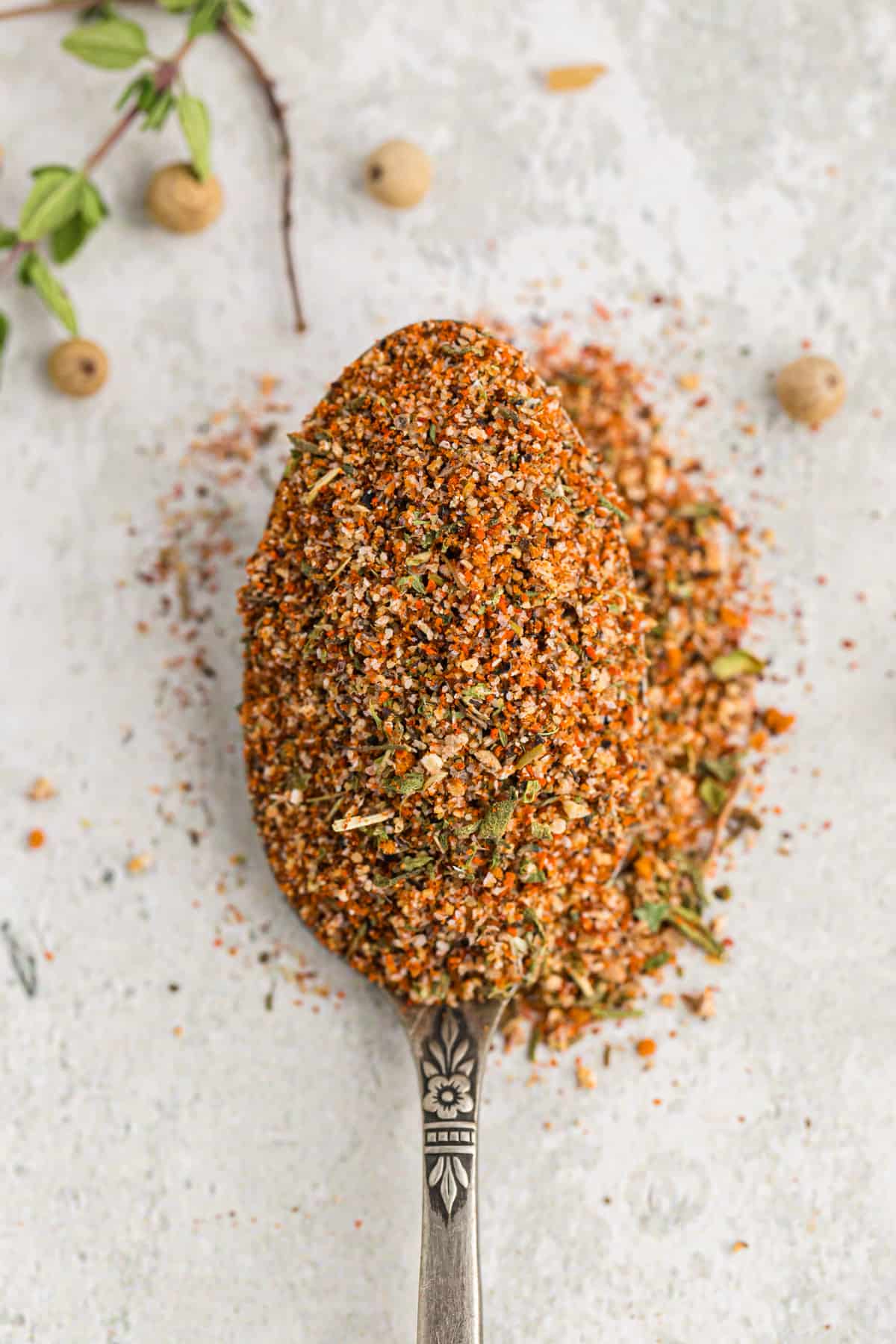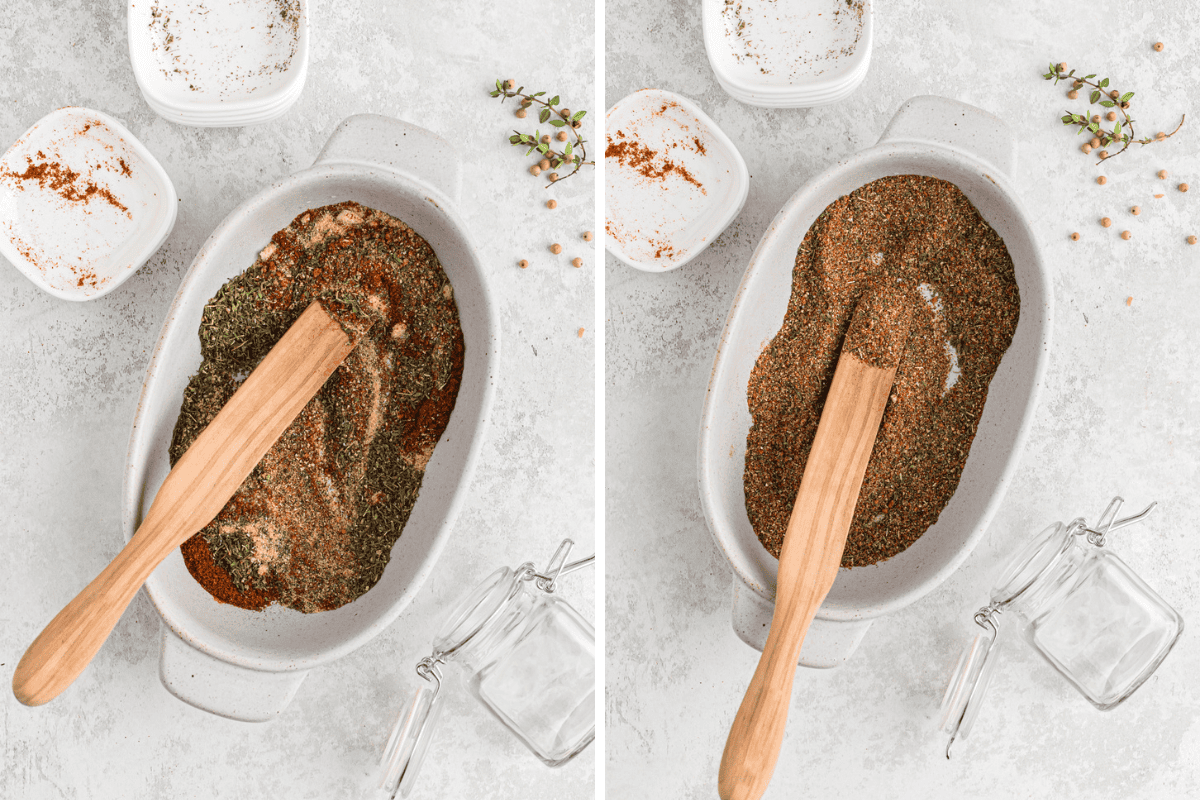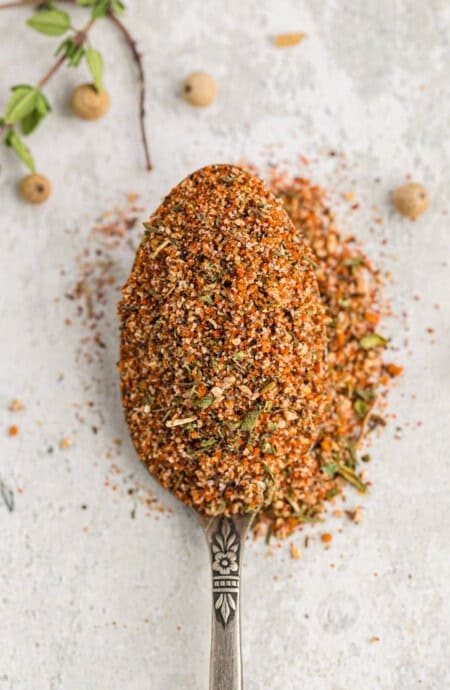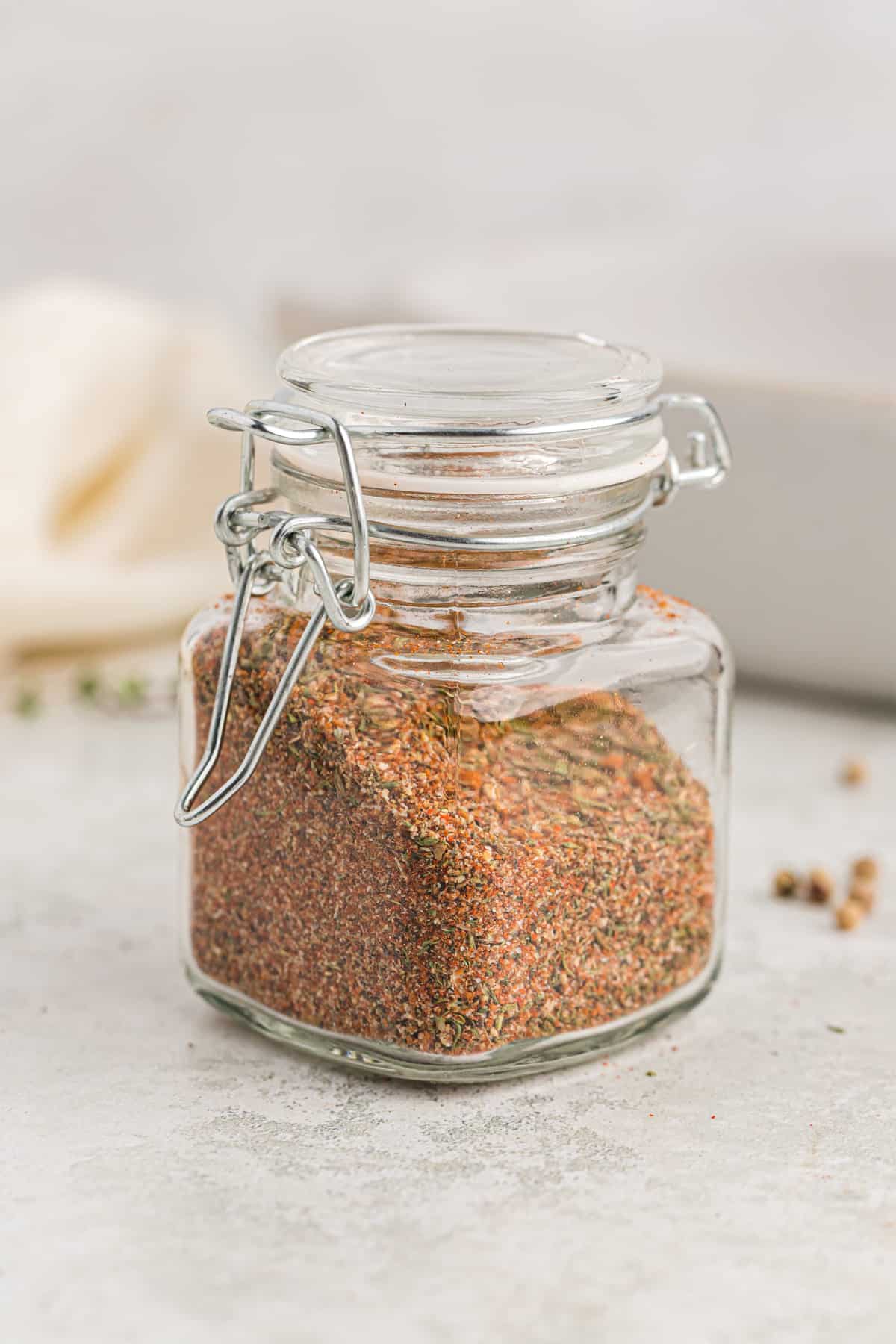Listen boos, this homemade Cajun Seasoning recipe will make you throw away the store-bought brand pronto. It’s got this bold, spicy and slightly herby thang going on that makes any and everything you sprinkle it on pop. Blend it up with some pantry ingredients and up your cooking game immediately. That’s what I call boss moves!
This post may contain affiliate links. Read our disclosure policy.

I don’t know about y’all, but I put Cajun seasoning on everything! I love to toss it up in pasta. I adore it on my air fried or grilled proteins because it livens it up so much. Honestly, it is a go-to for me. Once you learn how easy it is to whip up a homemade Cajun spice, I’m telling ya you won’t stop storing it up yourself.
I consider this recipe a guideline because cooking is more free flowing than baking. I tend to go off of vibes and flavor preferences when I’m not developing a recipe. This homemade Cajun seasoning recipe will provide you with the basics. Then go all in and make it just how you like it. Do you boo.
What is Cajun Seasoning?
Cajun seasoning is a spice blend used in Cajun and Creole cooking y’all. It’s usually got a spicy and bold flavor profile with a mix of savory spices like smoky paprika, garlic and onion for some aromatic essence and heat from pepper and cayenne. You can find it used in everything from gumbo and jambalaya to seafood and chicken. The sky is the limit.

The Lowdown on This Cajun Spice Recipe
- Cuisine Inspiration: Cajun boos!
- Primary Cooking Method: Just mixing
- Dietary Info: Gluten-Free, Vegan
- Key Flavor: Spicy, Smoky and Bold
- Skill Level: Easy!

Ingredients You’ll Need to Make this Homemade Cajun Seasoning Recipe
- Pepper: The trick is to use both black and white peppers y’all. We all know what black pepper is but white pepper has a slightly milder yet sharper kick of flavor.
- Garlic & onion powder: Let’s get aromatic with it! The garlic and onion powder give that savory roasted goodness.
- Cayenne powder: It wouldn’t be Cajun seasoning without some heat! Adjust the cayenne up or down, depending on how much spice you can handle.
- Paprika: Grab smoked paprika if you can. That smoky flavor adds some nuance to the final blend. If you can’t get your hands on it, regular paprika is just fine.
- Thyme: Just a smidge of dried thyme gives the cajun spice some earthiness. It pairs so nicely with hearty, Southern dishes.
- Mustard powder: Y’all, I love to add a dash of mustard powder for some tangy heat.
How to make Cajun seasoning
In a small bowl, mix the black pepper, white pepper, garlic, onion, cayenne, paprika, thyme, and mustard powder. You can add salt if you’d like, but I prefer to leave it out to season my recipes on an individual basis.
Transfer the seasoning to an airtight jar or container for storage!
Want to Save This Recipe, Boo?

How to Use This Homemade Cajun Spice Recipe
Boos, you can sprinkle this good ole Cajun spice on just about anything and flavor that baby up some. Whenever my food is lacking something, and I just can’t put my finger on it, I slide right up to my cajun seasoning and let it work wonders. Here are a few dishes you you can add a bit more pop and pow to:
- Protein: Shrimp, seafood, pork, fish, chicken, or beans.
- Starches: French fries, sweet potatoes, hash browns. It even livens up rice y’all!
- Sauces: barbecue sauce, remoulade, tartar sauce with a kick or even marinara sauce.
Recipe variations and substitutions
- Other herbs & spices: Try incorporating spices like oregano, basil, chile peppers, or cumin into your mix.
- Make it sweet: For more balance, add a little granulated or brown sugar to the mix.
- Add salt: Add salt for a one-stop-shop seasoning then you can skip that step later.
- No white pepper?: Just add in a bit more black pepper but don’t overdo it adding it in equal measure. Black pepper has a bit more kick so adjust. No black pepper? Sub with white pepper.
- No paprika?: If you ran out of this, throw in a bit of chili powder as a good sub.
How to Store this Cajun Seasoning Recipe
Once your Cajun seasoning is made, it should stay fresh for at least 6 months or even an entire year especially if stored in a cool environment. However, since you’ll be combining more than one ingredient, it’s best to check the expiration dates on each individual spice. This will give you a better idea of how long your spice blend will last. Make sure to add a label of the date it was made to keep you on your toes for replacing.
For the best storage, make sure to keep it in an airtight container in a cool, dark, and dry place. I like to store my cajun seasoning in jars in my spice drawer labeled of course.
Frequently Asked Questions
Cajun seasoning uses different types of peppers, including black, white, and cayenne. Because of this, Cajun seasoning usually has a bit more of a spicy kick for reals. Creole seasoning has a melting pot of cultures mixing it up in the spices. With Spanish, West African, Caribbean, and even Native American and German, it can sometimes lean a bit more herbaceous (with oregano, thyme and rosemary in the mix) and not as heavy on the heat.
Nope boos! Now if you do use freshly ground spices, it will give you more intense flavor without a doubt. However let’s keep it easy! Just grab pre-ground at the grocery store.
You can actually double some of the other ingredients to help balance it back out. Or scale back on how much you use. A little goes a long way. Finally, if you sprinkle it on your food and it is too spicy, you can create a nice creamy and refreshing sauce to bring that heat back down some.
More Cajun-spiced recipes
Now that you have a delicious, homemade Cajun seasoning, try it out in a few of these recipes:

Homemade Cajun Seasoning Recipe
Want to Save This Recipe, Boo?
Ingredients
- 2 teaspoons freshly ground white pepper
- 2 teaspoons garlic powder
- 2 teaspoons onion powder
- 2 teaspoons cayenne pepper
- 2 teaspoons paprika
- 1 tablespoon dried thyme
- 2 teaspoons ground black pepper
- 1/2 teaspoon mustard powder
Instructions
- Mix all spices together and store.

Hi Jocelyn. Your recipe is my go to for Cajun Spice – we cannot buy it here at the stores. It tastes lovely, and even if I find a recipe where the creators have a recipe have their own blend, it always tastes better with you ratios. Thank you for sharing.
Awe, thanks so much, doll!
Hi ! Is mustard powder the same as dried mustard?
Cajun Seasoning Recipe – Here’s a simple blend of common spices that … But to me, this homemade cajun seasoning tastes that much better.This is one cajun seasoning recipe that most cooks need in their repertoire, absolutely, … Anyone can make their own homemade cajun seasoning,
YES!!!! No salt! Thanks